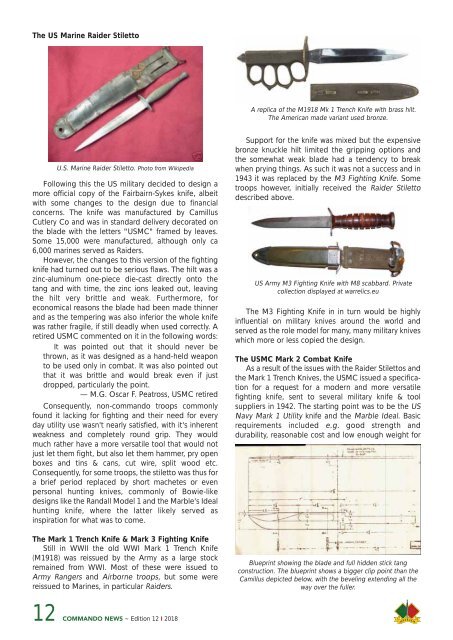Commando News Issue 12 2018
You also want an ePaper? Increase the reach of your titles
YUMPU automatically turns print PDFs into web optimized ePapers that Google loves.
The US Marine Raider Stiletto<br />
A replica of the M1918 Mk 1 Trench Knife with brass hilt.<br />
The American made variant used bronze.<br />
U.S. Marine Raider Stiletto. Photo from Wikipedia<br />
Following this the US military decided to design a<br />
more official copy of the Fairbairn-Sykes knife, albeit<br />
with some changes to the design due to financial<br />
concerns. The knife was manufactured by Camillus<br />
Cutlery Co and was in standard delivery decorated on<br />
the blade with the letters "USMC" framed by leaves.<br />
Some 15,000 were manufactured, although only ca<br />
6,000 marines served as Raiders.<br />
However, the changes to this version of the fighting<br />
knife had turned out to be serious flaws. The hilt was a<br />
zinc-aluminum one-piece die-cast directly onto the<br />
tang and with time, the zinc ions leaked out, leaving<br />
the hilt very brittle and weak. Furthermore, for<br />
economical reasons the blade had been made thinner<br />
and as the tempering was also inferior the whole knife<br />
was rather fragile, if still deadly when used correctly. A<br />
retired USMC commented on it in the following words:<br />
It was pointed out that it should never be<br />
thrown, as it was designed as a hand-held weapon<br />
to be used only in combat. It was also pointed out<br />
that it was brittle and would break even if just<br />
dropped, particularly the point.<br />
— M.G. Oscar F. Peatross, USMC retired<br />
Consequently, non-commando troops commonly<br />
found it lacking for fighting and their need for every<br />
day utility use wasn't nearly satisfied, with it's inherent<br />
weakness and completely round grip. They would<br />
much rather have a more versatile tool that would not<br />
just let them fight, but also let them hammer, pry open<br />
boxes and tins & cans, cut wire, split wood etc.<br />
Consequently, for some troops, the stiletto was thus for<br />
a brief period replaced by short machetes or even<br />
personal hunting knives, commonly of Bowie-like<br />
designs like the Randall Model 1 and the Marble's Ideal<br />
hunting knife, where the latter likely served as<br />
inspiration for what was to come.<br />
The Mark 1 Trench Knife & Mark 3 Fighting Knife<br />
Still in WWII the old WWI Mark 1 Trench Knife<br />
(M1918) was reissued by the Army as a large stock<br />
remained from WWI. Most of these were issued to<br />
Army Rangers and Airborne troops, but some were<br />
reissued to Marines, in particular Raiders.<br />
Support for the knife was mixed but the expensive<br />
bronze knuckle hilt limited the gripping options and<br />
the somewhat weak blade had a tendency to break<br />
when prying things. As such it was not a success and in<br />
1943 it was replaced by the M3 Fighting Knife. Some<br />
troops however, initially received the Raider Stiletto<br />
described above.<br />
US Army M3 Fighting Knife with M8 scabbard. Private<br />
collection displayed at warrelics.eu<br />
The M3 Fighting Knife in in turn would be highly<br />
influential on military knives around the world and<br />
served as the role model for many, many military knives<br />
which more or less copied the design.<br />
The USMC Mark 2 Combat Knife<br />
As a result of the issues with the Raider Stilettos and<br />
the Mark 1 Trench Knives, the USMC issued a speci fica -<br />
tion for a request for a modern and more versatile<br />
fighting knife, sent to several military knife & tool<br />
suppliers in 1942. The starting point was to be the US<br />
Navy Mark 1 Utility knife and the Marble Ideal. Basic<br />
requirements included e.g. good strength and<br />
durability, reasonable cost and low enough weight for<br />
Blueprint showing the blade and full hidden stick tang<br />
construction. The blueprint shows a bigger clip point than the<br />
Camillus depicted below, with the beveling extending all the<br />
way over the fuller.<br />
<strong>12</strong> COMMANDO NEWS ~ Edition <strong>12</strong> I <strong>2018</strong>

















